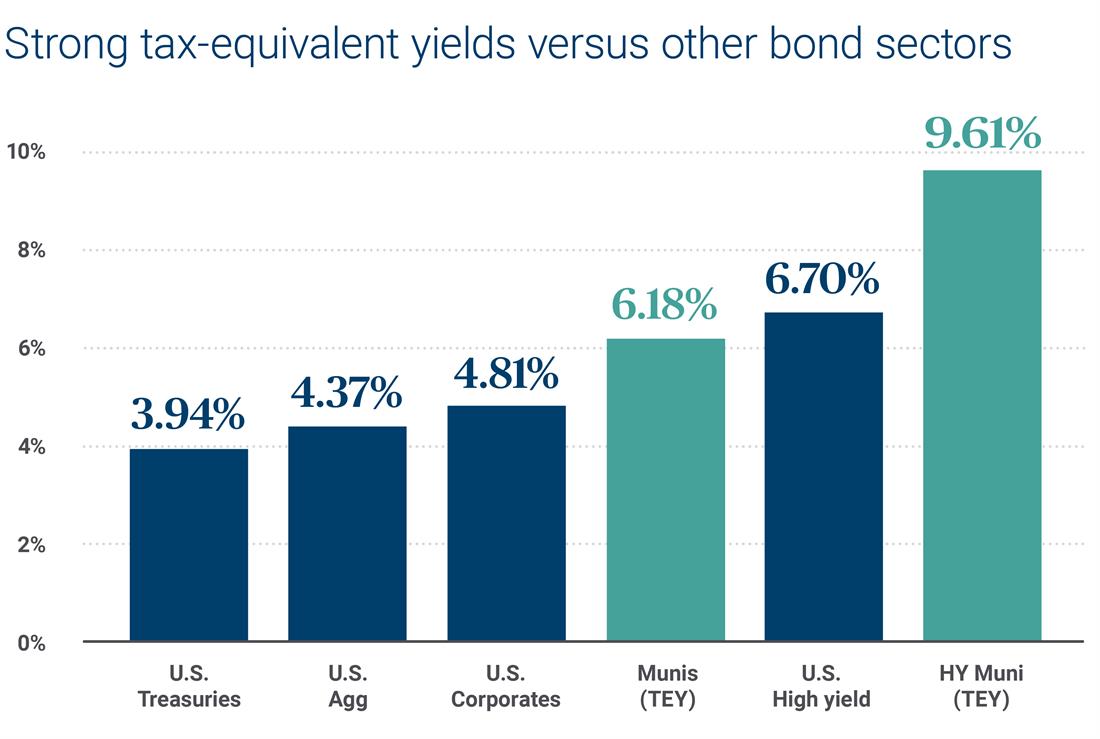Jason Appleson, Head of Municipal Bonds – PGIM
11/17/2025

Municipal bonds offer tax benefits and stability, making them reliable contributors to income-focused portfolios. And while they have always provided diversification benefits for investors, now may be an especially opportune time to explore how municipal bonds can support your financial goals.
Here’s an overview of municipal bonds, why this asset type may be especially relevant today and what opportunities may be worth considering in this space.
What are municipal bonds?
Municipal bonds, often referred to as “munis,” are loans issued by states, cities, local governments or not-for-profit organizations. These bonds finance a variety of public operations and infrastructure projects, from schools to transportation.
Why are municipal bonds attractive to investors?
Municipal bonds tend to be a compelling proposition for investors for the following reasons:
- Tax advantages: Interest earned on municipal bonds is exempt from federal income tax and, in many cases, state taxes if the investor resides in the issuing state. For issuers, this tax treatment allows them to borrow at lower yields compared with taxable bonds, providing an efficient funding mechanism. Municipal bonds help investors reduce taxable income and improve tax efficiency.
- High quality nature: Municipal bonds have a strong credit profile and low default rates, which are significantly lower than those of U.S. corporate bonds. This stability is supported by local governments’ reliance on property taxes, a less cyclical revenue source than income or sales taxes that also tends to lag broader economic trends.
- Stable returns in uncertain times: During recessions, municipal bonds often outperform corporate bonds because property tax revenue remains relatively stable.
- Lower risk compared to other bonds: Municipalities manage debt conservatively, using long-term, evenly amortized loans to minimize refinancing risk. Additionally, balanced-budget requirements at the state and local levels help ensure financial stability, allowing governments to reduce expenses or tap reserves to protect bondholders.
- Diversification benefits: Muni bonds’ low correlation with equities provides diversification and can help reduce portfolio risk. High-grade and high yield municipals also show lower correlations with the S&P 500 Index compared with other fixed income assets.
Is now a good time to consider municipal bonds?
Amid today’s uncertain conditions, municipal bonds are drawing heightened attention as investors seek dependable, tax-efficient returns. Tax-free yields are near their highest levels in more than 20 years, presenting an attractive opportunity for investors seeking tax-advantaged income.

Source: PGIM using data from Bloomberg as of September 30, 2025. All indexes are unmanaged. An investment cannot be made directly in an index. Past performance does not guarantee future results. Represented by yield-to-worst. U.S. Agg Bond Index: BBG U.S. Aggregate Bond Index; U.S. Treasuries: BBG U.S. Treasury Index; U.S. Corporates: BBG U.S. Corporate Bond Index; High Yield Bonds: BBG U.S. Corporate High Yield Index; Munis: BBG HY Muni Index; HY Munis: BBG HY Muni Index. Tax-equivalent yield (TEY) calculated using a 40.8% federal tax rate.
What tailwinds could support the municipal bond market?
We are increasingly optimistic about market technicals:
- Attractive valuations: While municipal issuers continue to borrow at a record pace, valuations and relative value appear attractive.
- Strong recent performance: Municipal bond performance has been strong in the second half of the year with the broader Bloomberg Municipal Bond Index posting a year-to-date total return of 4.27% through October. September marked the strongest monthly total return since December 2023 and the best performance in 16 years.
- Strong demand: Municipals are entering November and December with strong momentum supported by expectations for steady inflows, strong reinvestment and seasonally lighter supply. November has delivered positive returns in 16 of the past 20 years.
- Resilience amid slowdown: As U.S. economic growth begins to lag, solid municipal fundamentals should also provide credit support.
What challenges could the municipal bond market face?
Several macro policy risks could impact municipal bond issuers and investors. Investors should monitor these risks and focus on resilient credits to navigate potential disruptions:
- Spending cuts: While states face challenges from Medicaid cuts, waning COVID relief, tax reform and tariff shocks, overall state credit quality is expected to remain stable. However, midyear budget gaps and spending cuts could strain local economies.
- Policy uncertainty: Tax policy risk has abated somewhat since the passage of the One Big Beautiful Bill Act (OBBBA), although the current federal administration has been putting forward policies that threaten federal funding to several municipal sectors, including states, local governments, and higher education. Additionally, a prolonged federal government shutdown (i.e. longer than 60 days) could pressure budgets of some municipal credits, particularly in areas with a high concentration of federal employees.
- Health care pressures: The OBBBA cuts nearly $1 trillion in federal health care outlays over the next decade. Reduced federal funding for health care could put pressure on health care providers and states may aim to backfill the sources of revenue.
- Tariffs: A tariff-driven recession could lower corporate tax revenue and disposable income, reducing state revenue. For example, state revenue fell 4.5% in 2001 and 11% in 2008. While rainy-day funds offer some support, they may only cushion revenue declines by 1.7 times.
Where are there opportunities in the municipal bond market?
As federal aid tapers off, state and local governments face varied financial challenges, creating opportunities for active, research-driven investors. In this environment, we are focusing on higher-grade municipal bonds in resilient sectors for their strong value and lower risk.
We believe these themes will balance risk and reward while delivering solid returns:
- Short-duration munis over cash-like assets: As the Fed has begun to cut rates, cash products such as savings and money markets may lose their appeal. Short-term municipal bonds offer tax-exempt income, high credit quality and lower interest rate sensitivity.
- Longer over shorter duration for alpha: Underperformance on the long end of the curve this year could create a buying opportunity as the ratio of high-grade municipal bond yields to US Treasury yields is higher. This threshold is important from a psychological perspective as participation by crossover buyers1 generally picks up when this ratio is in the high 90s. The 15-to-+20-year segment of the municipal bond curve offers the most compelling carry and roll down price return.
- High-yield munis over corporate bonds: For higher income, high-yield munis stand out. They historically have lower default risk than corporate bonds and offer strong credit fundamentals. While spreads have compressed, we see potential for yield-driven outperformance.
- Resilient sectors for uncertain times: Affordable housing and gas prepay bonds backed by financial institutions are particularly attractive, offering value and credit quality in an uncertain economic environment
Bottom line
Municipal bonds offer compelling tax-equivalent yields. Still, many investors remain underexposed to this opportunity. With equity markets hovering near record highs and evolving dynamics in the Treasury market, reallocating to municipal bonds offers a chance to secure higher tax-exempt yields while boosting overall portfolio performance.
Interested in incorporating muni bonds into your portfolio?
An Ameriprise financial advisor can help you understand how muni bonds may fit into your investment portfolio, given your financial goals, risk tolerance and time horizon.